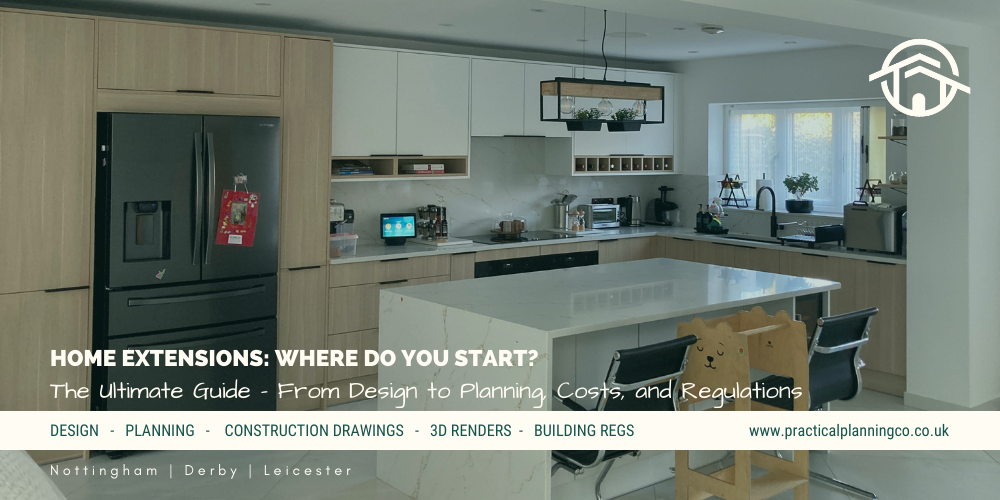Home extensions: where do you start?
The Ultimate Guide to Home Extensions - From Design to Planning, Costs, and Regulations
Is your home starting to feel a bit cramped? Perhaps your family is growing or the current layout of your home just isn’t working for you.
Whether you're dreaming of a spacious kitchen, an additional bedroom, or a home office, a home extension can be a perfect solution to add space and value to your property. This comprehensive home extension guide will take you through the various types of home extensions, shed light on the differences between those requiring planning permission and those under permitted development, and delve into the average costs, financing options, building regulations, and party wall agreements.
Types of Home Extensions:
Single-Storey Rear or Side Extensions
Single-storey extensions are a popular choice for those looking to expand ground floor living spaces such as kitchens, dining areas or living rooms.
For those craving a seamless connection between indoor and outdoor living, an open plan single-storey kitchen extension with bifold doors could be the perfect solution.
Double-Storey Extensions
Double-storey extensions provide a more extensive transformation, adding space both downstairs and upstairs. This option is ideal for growing families who need extra bedrooms or a home office. While a bit pricier, the benefits of a double-storey extension can significantly enhance your home's functionality and value.
Equally, a first-floor extension over an existing garage or single storey element is a great choice – and a bit more affordable.
Wraparound Extensions
A wraparound extension involves extending your home on two or more sides, creating a more cohesive and harmonious expansion. This type of extension is excellent for maximising the available space and achieving a balanced aesthetic.
Home Extensions: Planning Permission vs. Permitted Development
Now, let's talk about the nitty-gritty of getting your dream extension off the ground. Depending on your vision and local regulations, you might need planning permission or be able to use your permitted development rights.
Planning Permission
For those eyeing ambitious projects or living in conservation areas, securing planning permission is crucial. The process involves submitting detailed plans to the local planning authority, and approval can take several weeks. Local councils will review your proposed extension to ensure it aligns with planning policies, neighbourhood aesthetics, and environmental considerations. It might seem like a bureaucratic hurdle, but fear not – with the right guidance, and by working with a reputable local architect or architectural designer, your dream extension can become a reality.
Permitted Development
On the flip side, many smaller-scale extensions fall under permitted development rights, meaning you can proceed without formal planning permission. However, there are limitations and conditions to meet, such as not exceeding certain size thresholds (such as extending out by no more than 3m on a semi-detached property) and maintaining specific design aesthetics.
And it may be that your project falls under permitted development but you need to apply for what’s known as ‘Prior Approval’ for a larger home extension – or baby planning permission as we like to call it!
Again, a local architectural designer will be able to help you navigate the planning permission vs permitted development maze, turning your ideas into an approved blueprint.
Average Costs of Home Extensions
Now, let's talk about the big question on everyone's mind – how much is this going to cost? The truth is, the cost of a home extension can vary widely depending on factors like location, size, materials, and the complexity of the project.
On average, an extension in the UK can now cost anywhere from £2,000 to £2,500 per metre (this includes construction costs, materials, labour and VAT) due to the substantial rise in material costs and demand on labour since the pandemic.
While it may sound like a significant investment, the added value to your home and the newfound space can make it a worthwhile endeavour. Imagine having that extra bedroom for guests or a dedicated home office – the possibilities are endless!
To get an estimate on what our fees would be, along with the costs of planning permission, building regulations and a structural engineer, check out our handy fee calculator.
And if you take us up on our offer of a free, no obligation design consultation, we’ll be totally transparent from the get-go on whether we think your planned home extension is going to be worth it in terms of cost vs added value, and we might advise you to consider other options.
How to Finance Your Home Extension
Now that you have a ballpark figure in mind, let's explore how to finance your dream extension. There are several options to consider, each with its own set of pros and cons.
Savings
If you're sitting on a comfortable nest egg, dipping into your savings might be the most straightforward option. While it may feel like a substantial chunk, consider it an investment in your home's future value and your family's comfort. However, it's essential to ensure that you have enough set aside for unforeseen expenses.
Remortgaging
For those with substantial home equity, remortgaging is a viable option. This involves taking out a new mortgage or increasing your existing one. This can be a cost-effective way to fund your extension – especially when interest rates (hopefully) go back down! Just be sure to consult with a financial advisor to ensure it's the right move for your unique situation.
Personal Loans
If the amount you need to borrow is relatively low, one option is an unsecured - or personal - loan. This is a good option if you don’t like borrowing against your property and typically, there are no set up fees. To qualify, the lender - bank, building society or private lender - would need to look at your credit history and check you can manage the fixed repayments over the set time period.
As with all loans, it’s important to only borrow if it’s needed and planned for, borrow as little as possible, and make sure you’ve budgeted for the repayments. But again, do remember to factor in a contingency to cover any unexpected costs.
Navigating Building Regulations
Now that your plans are taking shape, it's time to talk about building regulations. These are essential standards, which have been recently updated, that ensure your extension is safe, structurally sound, energy-efficient, with proper insulation, and compliant with various legal requirements.
Working with experienced builders and structural engineers is crucial to meet these requirements. If you work with us, we can provide you with a list of local builders who have completed projects for previous clients.
Find out more about building regulations here: https://www.practicalplanningco.co.uk/architectural-advice-centre/ppco-guide-how-to-build-a-home-extension-4-building-regulations
Party Wall Agreements
Before you start swinging hammers and sawing planks, it's essential to consider your neighbours – and not just in the "borrowing a cup of sugar" way. Party wall agreements are a legal requirement if your extension involves work on a party wall or boundary line shared with a neighbour.
A party wall is a shared wall, fence, or boundary between two properties. If your extension project involves work on this shared structure, a party wall agreement is necessary. This legal document outlines the scope of the work, protects both parties' interests, and establishes a clear understanding of responsibilities.
In the UK, the Party Wall Act 1996 governs the process of obtaining party wall agreements. It ensures that neighbours are notified about proposed works and provides a framework for dispute resolution. Ignoring this crucial step could result in legal complications and strained relationships with your neighbours – something no homeowner wants.
Your Dream Home Extension Awaits!
Home extensions are a fantastic way to breathe new life into your living space without the hassle of moving – but beginning that design and planning journey can be daunting. From understanding the types of extensions to navigating planning permissions, financing options, building regulations, and party wall agreements, being well-informed is key.
Remember to consult with local professionals and home extension specialists who understand the unique nuances of your area to ensure a smooth and successful home extension project. If you're in Derby, Nottingham or Leicester, our team of architectural designers can help ensure your project aligns seamlessly with local regulations.
By combining creativity with careful planning, your dream home extension can become a reality, enhancing both your living space and property value.
No matter what stage you’re at in your project, our team is here to help. If you’re based in the East Midlands and you’d like to book in with our Derbyshire team for a free, no obligation design consultation, hit the button below - and stay tuned for some more practical tips!
Our fixed fee packages include all the necessary plans and guidance for a planning application. Plus, we handle the submission and all communications for you. For an idea of prices for designing and planning a home extension, please use our online calculator.
If you’re not quite ready to get started, or you’re based elsewhere in the UK, please feel free to check out the rest of our Advice Centre - and connect with us on Instagram and Facebook for tips and inspiration.

